Why Bloomreach Is the Best Experience Platform for Composable Commerce
By Paul Edwards
09/17/2021

The market is buzzing with the concept of ‘Composable Commerce’. Organizations are disassembling old monoliths and replacing them with ‘Packaged Business Capabilities’, which provide units of functionality that can be easily integrated into a wider stack. In the past, this has been referred to as “microservices”, but the change here is the word ‘composable’.
While some point solutions and integrators may bring some of the ingredients to the table, they do not make it easy for a marketer or a merchandiser to easily build, or compose, an experience. In order for an experience to be truly composable, the practitioner (merchandiser or marketer) must be able to create a campaign or landing page in a drag-and-drop graphical interface, which seamlessly talks to the technology underneath to make that campaign happen. You get to truly ‘compose’ the experience.
There is a trend right now where some believe that you can simply patch together a group of point solutions, but there are disadvantages associated with that approach. In this post, we are going to examine how the Bloomreach technology stack provides you with more business impact by bringing more of these pieces under one roof. Specifically, it does this by:
-
Providing business teams with the ability to compose experiences in a low-/no-code way
-
Sharing data between capabilities (e.g. CDP and Search) to make these experiences more personalized and relevant
-
Reducing the reliance on IT/Partners/Integrators
Packaged Business Capabilities
Gartner divides the technology stack in the following way:
- Capabilities (e.g. Commerce) are built on stacks. Stacks have 3 layers — Data, Logic, and View/API
- An Experience Layer, which exposes Capabilities to customers
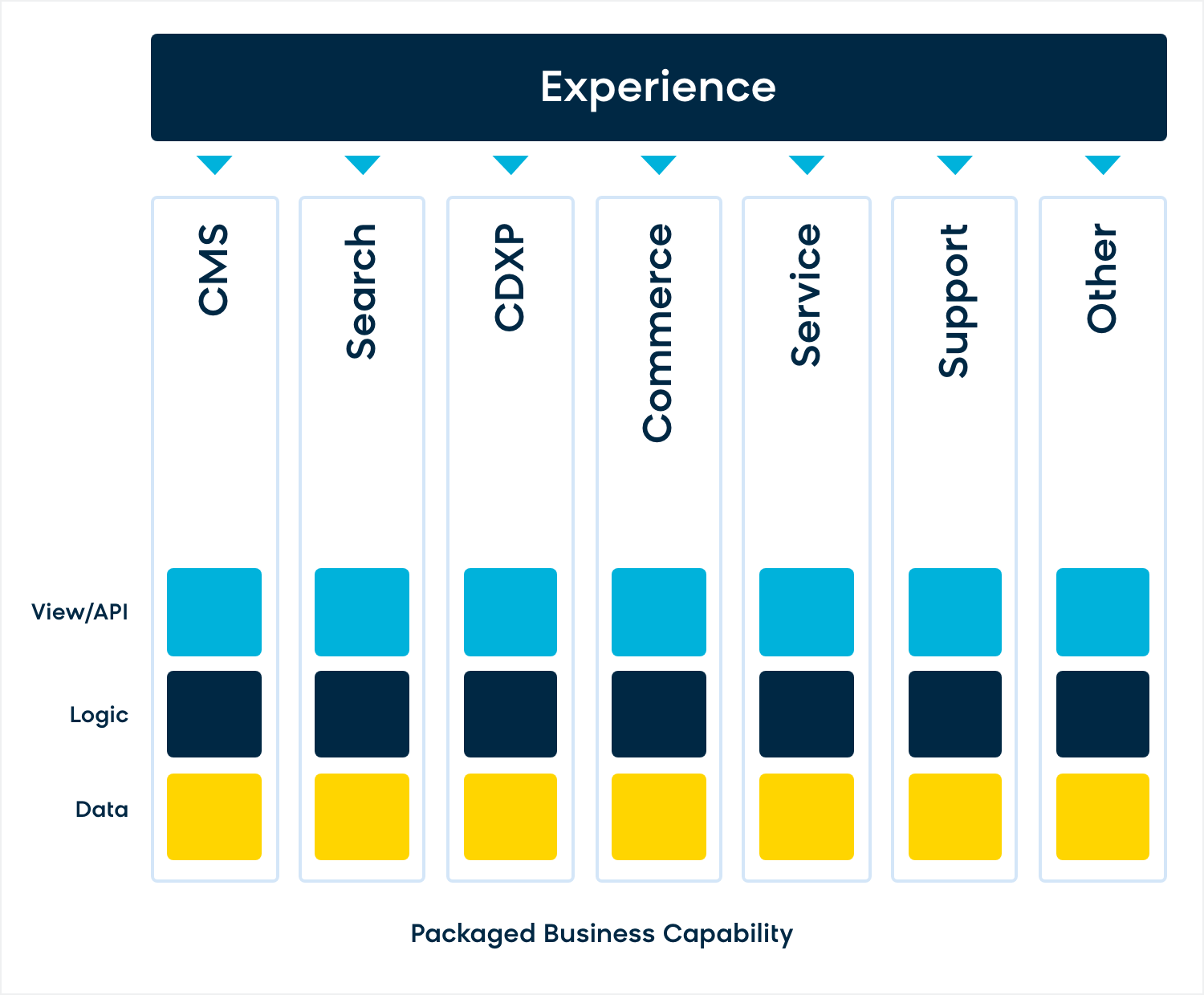
The whole idea behind composable commerce is that you break up your technology into distinct pieces and orchestrate them from an experience perspective. The challenge with that is that there is still a lot of information that needs to flow between the individual pieces of the stack to provide a cohesive experience for the customer.
For example, as a merchandiser or marketer, I want to serve personalized experiences to my customers. In order to do this, I need to segment customers inside a CDP and pass that information in real-time to both the search and website engines. I also need to pass signals back from the search engine and website about each customer’s affinities and preferences.
In order for the CMS platform to show the right recommended products on a personalized campaign landing page, it needs information from both the CDP and the search engine.
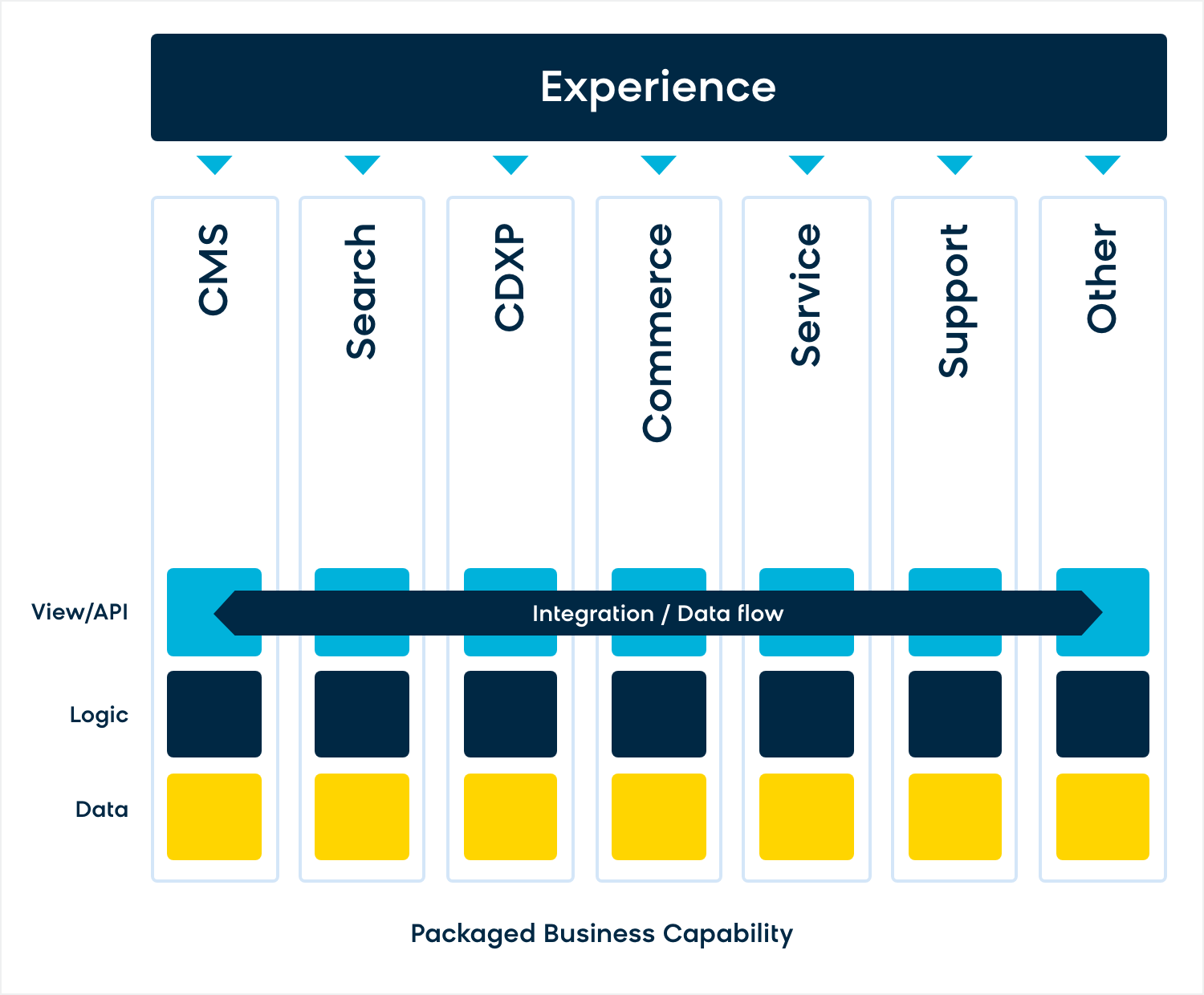
In other words, the above graphical representation is a bit simplistic. In reality, it looks more like this with lots of information being passed between the different stacks:
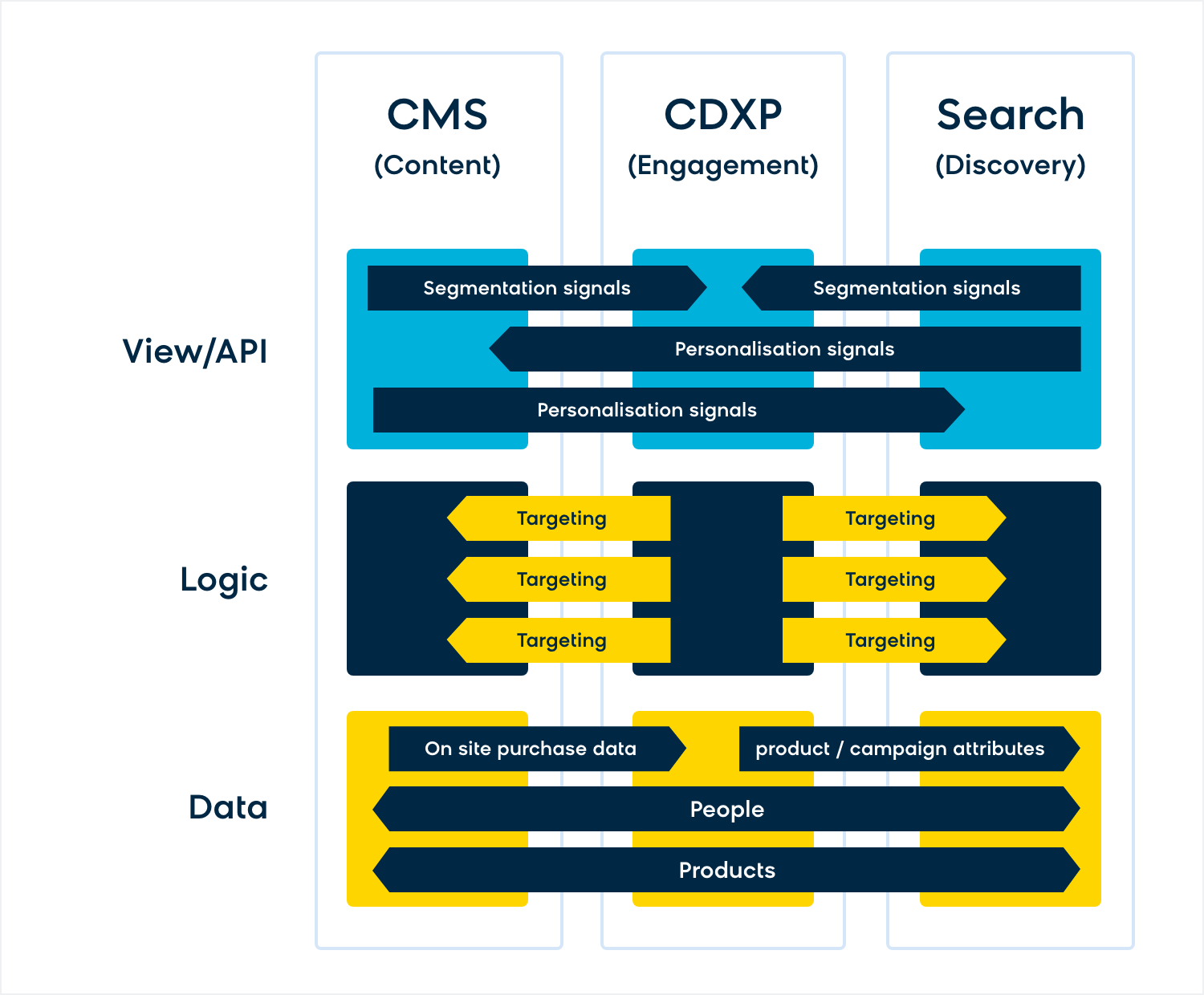 There is a clear danger here in over-fragmenting our Packaged Business Capability. We can easily turn our entire business into a bunch of point solutions that drive up our reliance on IT/Integrators. As a consequence, we would reduce the business team’s ability to react to the changing demands of its customers.
There is a clear danger here in over-fragmenting our Packaged Business Capability. We can easily turn our entire business into a bunch of point solutions that drive up our reliance on IT/Integrators. As a consequence, we would reduce the business team’s ability to react to the changing demands of its customers.
What can we do instead? We can still break our stack into pieces while maximizing the value for business users by packaging the component at the point that makes the most sense for the use case. If you just want to address a search use case, take that component — but if you want a fully personalized experience, take the packaging around the DXP + Search and Content.
This is ultimately why Forrester analyst Joe Cicman in his post says there is a need for an “integrated DXP, not just a box of rocks.”
A box of separate rocks means that you’ll need additional ongoing effort to integrate, design new business workflows (that may or may not exist in a no-code environment), manage third parties, write specifications, QA, triage faults, raise fault tickets, and all the other endless issues which are entailed in orchestrating loosely coupled systems.
Finding the Sweet Spot
At Bloomreach, we believe we’ve found the sweet spot — a way for our individual pillars (Engagement, Discovery, and Content) to act as individual Packaged Business Components, which build together to form a larger Business Component that seamlessly shares signals at the API, logic, and data layers. This saves our customers countless hours and cycles with IT/Integrators and frees them up to enable the business to meet the demands of its customers.
Customers are free to start with a single “Packaged Business Capability''. For example, they can start with Search and add others as and when the business need arises, working toward a goal of a fully evolved, Composable Commerce Architecture.
Evolved Composable Commerce Architecture
As you can see from the diagram below, the Bloomreach platform includes a number of Packaged Business Capabilities — namely, Engagement (CDP/Marketing Automation), Discovery (Search), and Content. These capabilities stand alone and perform exceptionally on their own. However, when a customer implements multiple, the fact that they can share signals and data in a truly composable fashion brings to life the ultimate promise of composable commerce. It allows the business to define and iterate on customer experiences — across all touchpoints — and on the fly (without having to call IT).
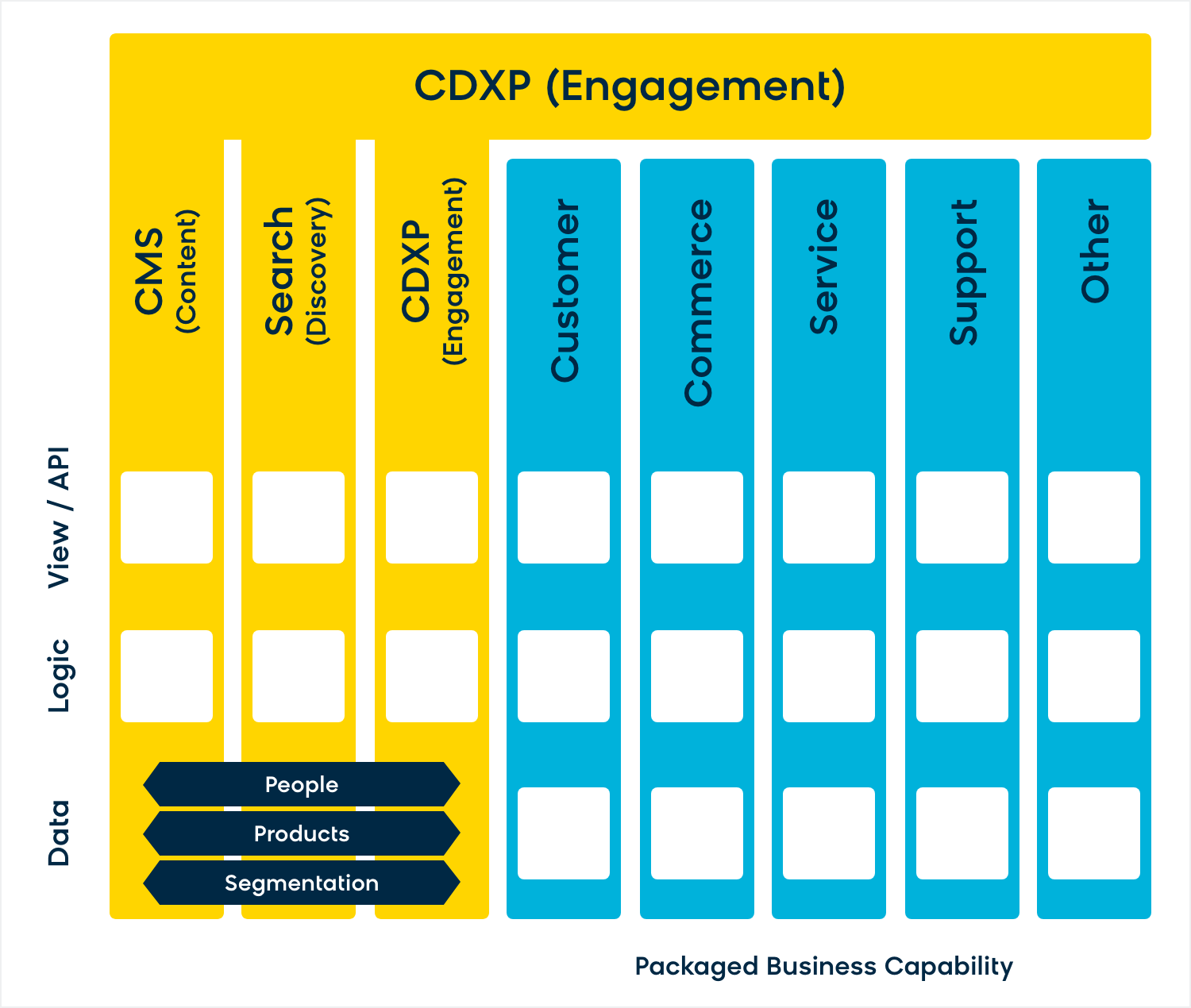
In summary, there are some key points worth noting:
- Our Individual Packaged Business Components (Engagement, Discovery, and Content) can stand alone and provide significant benefit on their own.
- When implemented together into a larger Packaged Business Component, the unified data layer (shared understanding of people, products, and segmentation) brings a rich set of customer understanding into the platform, which saves the customer integration effort and frees them up to achieve business benefits.
- Our Engagement (CDXP) Capability, extending over the top of the architectural stack, provides the orchestration of customer experiences, which enables overarching business benefits. For example, composing campaigns on the fly, creating lifetime customer analysis or dynamic segmentations, and utilizing these within landing pages and product grids — all from a low-/no-code interface. (Gartner identifies this as a characteristic of Composable Commerce).
To cite Joe Cicman, who writes about what an “integrated DXP” means: “A DXP that integrates journey orchestration into a single pane of glass is good and helpful. A DXP that offers content up to another vendor’s journey orchestration tool is just doing what’s expected of any service that can be orchestrated.”
In other words, with a fully integrated DXP, running your business is less stressful. Your business is more responsive to the needs of your customers as you can write processes, create landing pages, or manage product grids without any coding. You spend less time raising IT tickets, thinking about problems with integrations, or negotiating unexpected limitations of point solutions.
Evolved Composable Business Capabilities
Bringing individual functional areas into a Packaged Business Capability not only allows us to share signals easily between functions but it also serves the ultimate goal of Composable Commerce: experience orchestration for the business user.
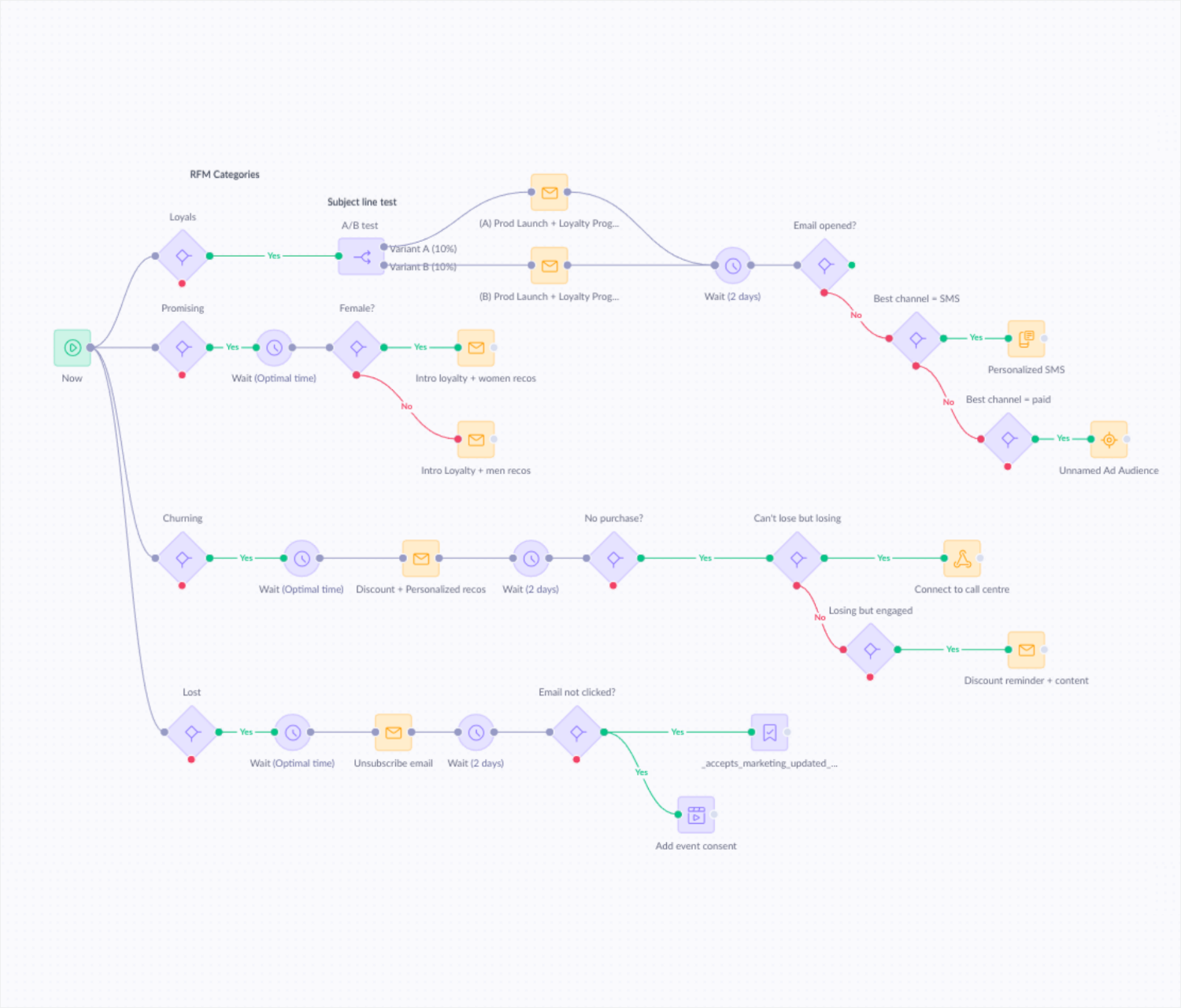 Experience Orchestration using Bloomreach Scenario Builder
Experience Orchestration using Bloomreach Scenario Builder
In the diagram above, a practitioner needed to build a retention campaign to encourage a second purchase. They have built out a scenario using our drag-and-drop UI, which reacts to customers based on recency/frequency/monetary analysis of their engagement with the company. The process implements a number of automated strategies (e.g. re-engagement emails or texts) to get customers who are at risk of being lost to re-engage. When customers click on the communications, they land on personalized landing pages and become loyal customers, or even champions for the brand.
Conclusion
The Bloomreach architecture represents a sweet spot that helps our customers on their journey from monoliths through to Packaged Business Component and then on to achieving the ultimate goal of Composable Commerce: true composability for the business user.
If you want to learn more about this topic or how Bloomreach can set your business up for ultimate success, schedule a personalized demo with our team.
Found this useful? Subscribe to our newsletter or share it.





